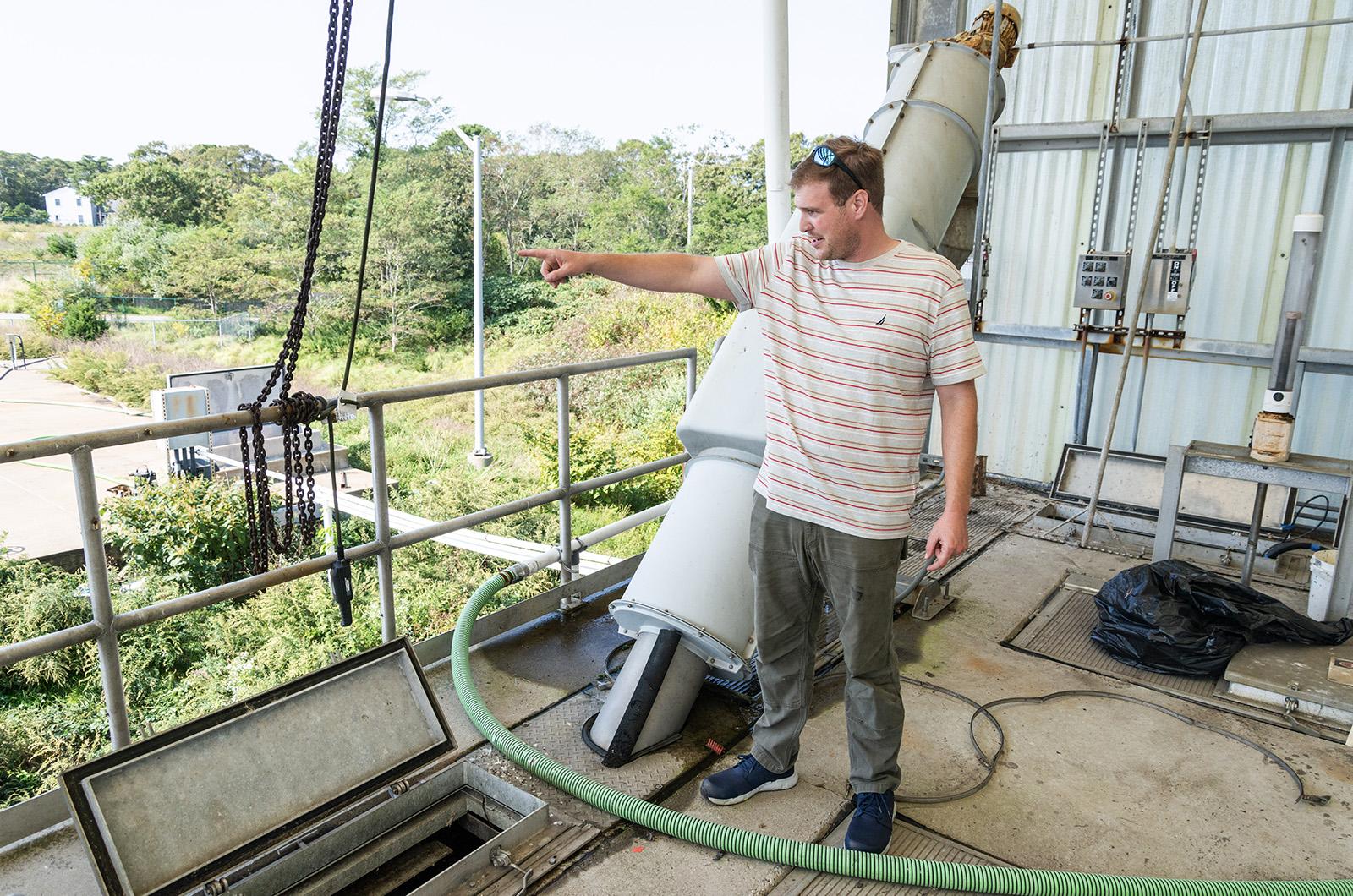Electrical engines whir in a long concrete basement of the Oak Bluffs wastewater facility, heating the air and pumping thousands of gallons of effluent into treatment tanks. Thick black pipes jut from the wall, circulating fluid and sludge.
Facilities manager Patrick Hickey has spent hundreds of hours with this system, greasing bearings, adjusting valves, examining microbial wastewater samples. Even when traveling off-Island Mr. Hickey is plugged in, connecting to the plant’s computer control system with his smartphone.
But as soon as next year, Mr. Hickey plans to say goodbye to these old pipes. The facility is poised to undergo a complete makeover in the next few years, reconfiguring the infrastructure and increasing the capacity for the town, hooking up new neighborhoods to the plant.
The estimated $44.4 million upgrade is the centerpiece of Oak Bluffs’ new wastewater management plan, which recently won approval from the state Department of Environmental Protection (DEP) and is meant to address nitrogen pollution in town.
“Everything will be changing down here,” Mr. Hickey said on a recent tour of the facility. “All this stuff is 20 years old.”
The plan has been in the works for around five years and passed its final phase of state permitting Monday, when the Massachusetts Environmental Policy Act Office (MEPA) approved the project with only minor engineering changes.
Most nitrogen pollution in Oak Bluffs — and across the Island — originates from on-site septic systems. Around 85 per cent of homes in Oak Bluffs use septic, according to a sewer commission data, many of which leech nitrogen into sensitive watersheds like Lagoon Pond.
Treatment at a central facility can remove nitrogen at a much higher level than septic systems and redirect outflow from sensitive areas. The Oak Bluffs facility now mostly serves downtown, but the new wastewater plan aims to drastically expand service, hooking an estimated 383 homes in the Lagoon Pond watershed.
But to hook up those new homes, the plant first needs an overhaul, said Gail Barmakian, an Oak Bluffs select board member and wastewater commissioner.

“We want to increase our capacity flow an enormous amount. So, the first phase is to get the plant updated, ready, expanded,” she said.
Preparing the facility for that increased flow will require a complete paradigm shift in the way their plant operates.
In the current system, after passing preliminary filters, wastewater enters a treatment tank where microbes begin to break down the waste while pumps keep the mixture circulating.
“As a plant operator you kind of keep [the microorganisms] healthy and happy,” Mr. Hickey said. “And you keep the right population for the waste that’s coming in.”
After the microbes finish their work, the mixture is allowed to settle. Water is pulled off the top for a final sand filtration process, while solid “sludge” is pumped off the bottom, shipped in trucks to a sludge incinerator in Rhode Island.
It is that final phase of settling and filtration that slows down the process.
“That process isn’t exactly instantaneous,” Mr. Hickey said. “You are always limited by your weakest link.”
With the new system, he said, they will not have to wait for solids to settle, instead pumping the mixture through a high-tech membrane filter to separate them out.
That membrane also removes the need for the sand filtration system, which will be replaced with a dewatering system to reduce the water content and weight of their sludge, lowering the cost of off-Island transport.
These, along with a series of other upgrades and changes, will allow the facility to process more wastewater without increasing the footprint.
Now, said Ms. Barmakian, the focus will shift to secure funding for various aspects of the overarching wastewater plan, including a program to install nearly 800 nitrogen-removing, innovative/alternative septic tanks in town.
Over its 20-year timeframe, the plan anticipates about $103.6 million in costs, including the sewer upgrades. Ms. Barmakian emphasized that the town might not be on the hook to pay for the entire project, saying that there are “a lot of pockets,” they can pull from.
A variety of funding sources, from forgivable state loans to the Cape and Islands Water Protection Fund, which allows towns to enact a 2.75 per cent tax on short-term rentals and lodging to fund wastewater projects, are on the table, Ms. Barmakian said.
A draft of the warrant for the Nov. 7 Oak Bluffs special town meeting also includes an article proposing the creation of a town wastewater stabilization fund.
She said the select board is also considering whether to enroll the town in the Cape and Islands water fund, which requires towns to have an approved wastewater plan.
But now that the project has received state approval, Ms. Barmakian said, the most difficult regulatory hurdle has been passed.
“It’s a complicated regulatory process,” she said. “Hopefully in the next year we’ll start digging.”






Comments (1)
Comments
Comment policy »